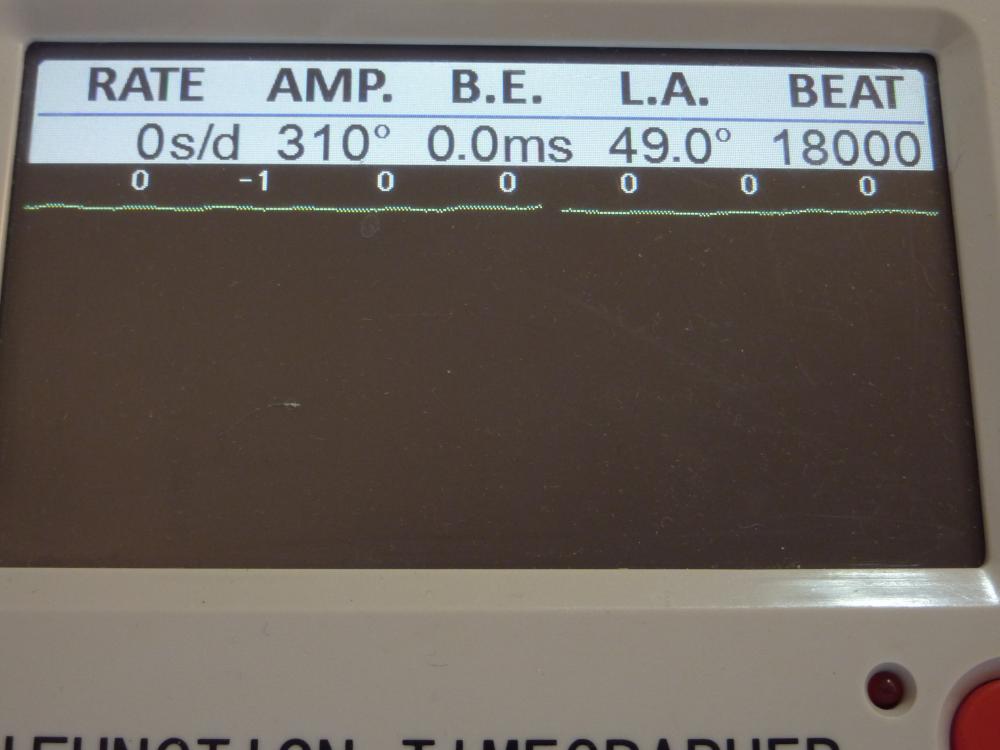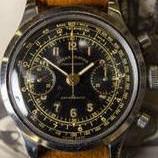Leaderboard
Popular Content
Showing content with the highest reputation on 10/06/16 in all areas
-
I haven't done one of these for a while and as this is my 1000th post I thought I would do something a little less ordinary. As the title says it's one of those crazy Russians, a USSR Sekonda from the 70's sporting a Slava 2428 in all its quirky glory. This one came to me as a non-runner and a preliminary investigation turned up a broken balance pivot so it went into the "to do" box until I could source a replacement, which it turned out I had all along from another watch previously scavenged for parts a while ago, as I discovered during a recent tidy up. So here goes...... Looking a bit sad, a grubby face and a bit of corrosion on the hands, and as already mentioned, not running. Also the date corrector pusher which is above the crown is jammed in. It's obviously seen a bit of wear in its time as the plating to the rear of the case has started to go through. Inside doesn't look too bad. Dirty and dry for sure but I've seen worse. The stem however suggests that things may not be so good further in. Uncased and the dial doesn't look so bad. The hands may need a bit of a spruce up. Oh dear... with the dial off the hint that the stem was giving earlier becomes a grim reality and the reason behind the frozen date corrector is clear. Heavy rust around parts of the date quick set mechanics has seized everything solid. With the day and date wheels out of the way and safely bagged the full extent of the problem can be seen, and maybe it's not quite so bad after all so long as none of the screws shear off as I try to undo them. Success.... all the screws out and nothing stripped. The rusty parts have been carefully rubbed down and are now enjoying a strong cup of tea.....to stabilise the remaining rust deposits. And here is the first quirky bit, all of the date quick set mechanics are mounted on the movement ring, not the movement itself. Strange but true! The movement now flipped, balance cock and barrel bridged removed, and the second and third deviations from the everyday run of the mill design philosophy become apparent; that curiously asymmetric pallet fork, and those tandem main spring barrels. The first of the going train bridges removed .... ... and with the second train bridge and wheels removed, the replacement balance is installed without jewels ready for a spin in the Elma. And here we have all the bits nice and shiny out of the cleaner, with as much of the rust issue dealt with as possible. Is it me or are there a hell of a lot of wheels in this little baby? Both main springs are in good shape so they are greased and rewound into their respective barrels. I don't know if it was strictly necessary but I did take the precaution of keeping the barrels, lids, and arbors together as sets during the cleaning process so that the same bits went back together as came apart. Balance jewels inspected, lubricated, and reinstalled. The hair spring is pleasingly flat, parallel to the balance, and concentric, and once set in motion the balance doesn't seem to want to stop. A good sign... In goes the first set of train wheels along with the idler that couples the twin barrels together. With the first train bridge in place the escape wheel and centre seconds wheel are installed. Second train bridge goes back on followed by the tandem barrels Barrel bridge with all of those amazing coupling wheels to keep everything turning the right way all the way back to the crown wheel and its clearly marked lefty screw. At this point all of the pivots have been oiled and a quick test of the free running of the train is done. A couple of clicks on the ratchet wheel and the escape wheel spins nicely down and then back with just a little recoil. After that the pallet fork goes back in and the pallet stones are lubricated. Typical of many Russian watch movements, the balance cock has a shim. Whether or not these were available in different thicknesses so that end shake could be adjusted I have no idea. I've never had a problem swapping them between watches though which suggests that they are all the same thickness. Balance back in and that lovely moment when it starts to beat again. And then back into its big metal spacer ring come date quick set extension. Time to rebuild the dial side. It's a bit cleaner now. Keyless works back in place. Motion works reinstalled. Incidentally, as can be seen here 5 of the 26 jewels are vertical rollers for the date wheel and 4 are set into the main plate for the date wheel to ride over. Cynical marketing ploy anyone?? The date corrector mechanics are reinstated into the movement ring, all now free running. Most of the rust damage cleaned up reasonably well but there is significant pitting at one end of the spring. If I ever find a donor I will replace the worst affected parts but for now they work and the rust has been stopped. Calender wheels back in place. Date wheel back in place and the day wheel jumper and spring installed. Day wheel drops into place. Dial and hand back on following a clean up and a little fresh black paint in the hands where it was beginning to crack. This is the date corrector pusher and is I suspect the origin for the water ingress that caused the rust damage. It has a little neoprene seal on its back face so that the spring tension should seal it against the inside of the case. It was bone dry and all it would have taken is a little dirt stopping the pusher from closing properly and its an open invite for any contamination that comes along. Now cleaned and re-lubricated with silicon grease it will hopefully keep the water out. Re-cased and ticking away nicely. With the exception of the date corrector pusher issue these are well designed cases. Although they make no claim to water resistance they do use a design similar to that used in the Vostok Amphibia cases, with a thick gasket, a steel back that drops into place, and a threaded clamping ring to hold it all together. Looking a lot happier than when this all started. You can now see the date corrector pusher protruding from the side of the case above the crown so it is definitely sealing against the inside of the case. A new crystal allows the cleaned up dial and hands to look their best. And there is something about the dial layout and hands that just seems so Russian to me. I really like it. And of course the proof of the pudding.... This is dial down. DU was almost the same, only difference was amplitude which fell to 298. The vertical positions showed a tiny bit of beat error, up to 0.4ms, amplitude down to around 275, and slight rate errors, coming in at -5 s/d at one extreme and +3 s/d at the other, quite a respectable result. Maybe those crazy Russians aren't quite so crazy as they first appear. The little design quirks here all add up to a nice piece of engineering. The train wheel layout, and the asymmetrical pallet fork allow for a comparatively large balance wheel for this size movement (thinking about it without the date quick set and the extension ring). The use of 2 main springs running in tandem allows for a more even torque delivery as the springs wind down which should help to reduce isochronism errors, while also making good use of the available space. It all actually makes quite good sense in a kind of lateral thinking sort of a way. If you should be tempted to go for one of these then I would suggest that the earlier USSR ones are the better ones to go for. The later "Made In Russia" versions at some point were updated to a 21600 train, but weren't so well finished, and that date corrector/spacer ring became plastic with the mechanics riveted on, presumably to reduce costs. Bit of a shame if you ask me. If you made it this far then I guess I haven't bored you to sleep. Thanks for reading.3 points
-
As a reminder this isn't your typical watch. Besides all the complications of an automatic chronograph it is also running at a speed twice as fast as a normal watch. Lubrication is definitely an issue for the 36,000 bph watch and if it hasn't been serviced in a while running slow may be an indication of that. You really need to have a timing machine Not just to look of the rate but to look at the amplitude verify the watch is running correctly and just needs to be regulated. Then the screw is for fine adjustment regulation it has a floating stud holder and regulator pins are also floating so they're all independently movable. Lots of adjustments and lots of ways to go wrong without a timing machine. http://watchguy.co.uk/service-repair-movado-datron-diver-chronograph-zenith-3019-phc/ http://www.ranfft.de/cgi-bin/bidfun-db.cgi?13&ranfft&102&2uswk&Zenith_3019PHC3 points
-
Please take it to a watchmaker for a service. If you manage to regulate it without breaking it, it will still need a service...2 points
-
I have looked covetously at those Bergeon hand gauges on many an occasion, even put in the cheeky bid only to loose out to someone with better finances, but the truth is I simply can't justify the cost. Measuring the inside diameter of hands is something that I don't often need to do but when I do need to I use the poor man's approach :-) A brass taper pin, a CD pen, and a vernier caliper. The taper pins can be obtained in a variety of sizes from clock supply houses for not very much and are extremely useful in all sorts of situations. This one goes down to 0.2mm which is fine for most hour and minute hands; seconds hands may require a slightly smaller pin. The hand slides down the pin until it stops, and the pin is marked with the CD pen. This is a minute hand for an ETA 2783. With the hand removed the pin is measured at the pen mark using the vernier caliper. In this case 0.9mm. As I said, I rarely need to do this but when I do it's when I am sorting through my collection of salvaged hands to try and find one to fit a particular job, in which case I actually adopt a slightly different approach. I measure the post that I need to find a hand to fit. Then using the caliper I locate the point on the taper pin that corresponds to the required diameter and mark it with the pen. I then simply drop the potential candidates onto the pin and see how close they get to the mark. If they are too big then they will drop to below the mark and are rejected. If they stop at the mark then they are the required size. If they stop above the mark then depending on how much too small they are they are either rejected or broached out until they fit. Simples2 points
-
Sometimes you get lucky and for me, it looks like this is one of those times. Here I have a vintage Navitimer that I picked up for a fair price but also with a fair bit of risk involved as it was bought online and in non-working order. Under inspection following receipt I discovered that dial wasn't seated properly and pushers were jammed. Things were indeed looking bad. Imagine my relief upon seeing this under the microscope. That would be a case screw hiding under the fourth wheel! Unfortunately it's sheared off in the case, but the good news is that the movement started ticking merrily away once the screw was extracted and with the works unjammed the pushers are operating properly again. With luck, a simple cleaning, alum bath, and a new case screw will be all this one needs. (knocking on wood)1 point
-
If you're able to watch BBC4 on UK TV this evening, there's a programme on the history of the Breguet timepiece made for Marie Antoinette - she of eating cake and being guillotined fame. It's presented by Nicholas Parsons who, I hadn't realised, is a keen watch man. Cheers, Will1 point
-
Hello everyone. I am relatively new to servicing of watches but my background is in the retail side of watch repairs. You know, fitting straps, battery & reseals, bracelet repairs etc. I've started to strip down and service a few automatic movements from my own collection and things have gone well. Set up a little bench at home and got some equipment including that awesome vintage L&R cleaning machine... I have a question about a 2824-2 movement but I will ask about that in a separate post since this is about introducing myself. I look forward to speaking with you all. David1 point
-
I like to use the 1A since it limits my interaction with the cap jewel, which can easily get away from a novice like me. I am considering the 2A for pallet forks.1 point
-
1 point
-
The M/s beat error is entirely up to you but with a better amplitude you should be able to adjust it nearer 0.0 but if your adjusting face down to 0.0 then face up will be different same as crown up and down will be different its all about finding that sweet spot in all positions no watch ever runs at 0.0 beat error in all positions you have to remember there's friction gravity and temperature to take into place too.1 point
-
Thanks Seiko! I was suspecting some trouble of that nature...I hope it could be confirmed.1 point
-
I got the 1A oiler to use on Seiko diafix jewels. They are a pain to oil manually. Right away I broke the tip of the oiler. Got a new tip, dropped the oiler while replacing the tip, thought for sure I'd broken it again, but no, just bent a bit. Works OK. Got it adjusted, those diabolical diafixes are now a piece of cake1 point
-
On current Seikos, approx 200 deg. is the very minimum. Swiss / better movements, 230. The more demanding the watchmaker, the higher the value. NB: No need for you to struggle showing the actual movement on the machine. I do that on selling pictures to show that is genuine1 point
-
I wish we here in the US could view this. We only can watch "Trump & Clinton" Propaganda , so we watch nothing1 point
-
Best place for You is here! Experienced and noob (like me ) watch- and clockmakers sharing knowledge with each other. You can also find high level watchmaking secrets all over the site and on the net. It is worth reading and watching videos, especially Marks videos.1 point
-
Is the upper balance jewel spring secured correctly? Maybe just a trick of the light but it doesn't look right. If that's not the issue, let down the power, remove the pallet fork and make sure the train spins forward freely and then bounces back when you apply one click of wind. Leave the pallets out and refit the balance. Does it spin freely? If any issues with the above it is likely you have dirt in a jewel or on a pivot, or possibly a damaged pivot. Given the snow on your timegrapher, my guess would be this is a balance / pallet issue.1 point
-
Here's a typical case I have got today, Seiko 6R15 which should be just 4 years old: Again, in my experience "cleanliness", magnetization, or interference have nothing to do with the problem. I will service this and I hope I can get it to normal, but sometime all one gets is a 20 deg. improvement, not enough when starting at 155. In these cases unless the owner is OK with crappy and unpredictable timekeeping, all what can be done is swapping with for new movement, or try replacing escapement and balance.1 point
-
Thats a jap Tokia love rock in my profile pic I have too many guitars like watches according to the wife also in the list is a Gibson les Paul a fender Tele a Squire strat with some beefy iron works pickups in it then there's my cort that's always out and at hand for practising not to mention a couple of acoustics one being a 60's harmony probably the nicest acoustic I have.1 point
-
Also be careful holding your phone near the timegrapher as you will get noticeable interference. I agree wit the others: get the amplitude up (was it fully wound?) and then start making judgments.1 point
-
Washing up liquid is usually fine. A warm temperature (say 40c) can help. Don't run your ultrasonic for extended periods like over 10 mins without giving it a break to cool down as they can fail for this reason. For cases, I usually find that hot tap water works fine as a rinse.1 point
-
Low amplitude on 7S26 is a common problem which is very difficult to correct. Happened to me quite a few times and cleaning things again and again did not helped of course. Neither replacing the main spring or barrel complete did help. I think it has more to do with 1. Having a perfectly shaped hairspring in order to deliver the maximum elastic impulse to the balance, and 2. The ideal angle and depth of the pallet stones. Both things are very difficult to get right for a beginner.1 point
-
1 point
-
Hello and a big welcome David i like your setup very neat and tidy i'd love a room of my own but alas the kids wont leave home.1 point
-
I'll record that and i hadn't realized Nicholas Parsons was still alive. Takes me back to being a kid Sunday night in front of the b/w telly watching " From Norwich its the SALE OF THE CENTURY " oh happy childhood memories.1 point
-
I have yet to find a timex watch you can actually service all those riveted plates make it impossible.1 point
-
Looking at your vid the first thing i notice is your amplitude is low and the graph line is very erratic to start with have you de-magnatised the movement have you checked all pivots while cleaning making sure none are too worn or bent is the hairspring catching anywhere Low amplitude is usually something to do with the amount of power being transfered through the gear train and not kicking the balance wheel round with enough power seikos are usually have a lower amplitude but not that low I would check again all pivots and pivot holes are spotless.1 point
-
Years ago I would disassemble Timex watches with a hammer because there **BLEEP** rubbish.1 point
-
Thought some of you might find this interesting, i did.1 point
-
Can you post few pictures? Videos are large to handle as attachment, better to upload to a dedicated platforum.1 point
-
If you replace the battery and it doesn't burst into life, hold the watch tightly face up and give it a bump with the heal of your other hand in either the 9:00 or 3:00 position. This will often get them going as it can start the tuning fork vibrating. If it starts the watch, it could just be needing a service. If this doesn't it wil definately need a service and/or repair.1 point
-
I only use the 1A when access is not possible with regular oiler. The other sizes offered I see no reason for them apart from a guaranteed amount oil dispensed.1 point
-
In my 30 something years as a watch/clockmaker I have never used such tools. I would think there the tools for a watchmaker who has everything and money to burn. Could someone tell me what the advantage is.1 point
-
If you are servicing movements on a regular basis, then I would highly recommend them, I have automatic Bergeons, and also use manual oilers too, I tend to use the auto oilers on all Swiss movements, and the manual on all other movements.1 point
-
Well I blew my budget on the watch I'm afraid. It will have to do with the standard black leather strap. I'm always struggling for cash when it comes to the bracelets!1 point
-
Actually when you order balance staffs you're always taking a chance for variety of reasons. I once purchased a new Hamilton staff in an envelope sealed only to find the pivots were slightly rusted. Or for instance Bestfit has replacements staffs and they're almost always oversized on the grounds that you can reduce them to fit. So for the unsuspecting buyer assuming that they fit your in for a surprise. So one modern watches brand-new in the package they're usually going to work. Older watches American pocket watch is where we don't know where the staffs are coming from anymore it becomes extremely important to measure the before and after staff to make sure everything's going to fit. I agree on the picture it hopefully is an optical illusion it does look not quite right. I find when you're looking at staffs even with your loop it helps to rotate them because sometimes even then you'll get an optical illusion it looks bent..1 point
-
THanks i see you gibson les paul i have a gibson midtown / p90's , ovations standard balladeer cut away. ibenez artist edition f hole, and of course a stratocaster .. i am an avid closet player, i used to play out by my partner died, all things must pass,, glad to be alive and at the bench!! and thank you for all the replies WRT !! sitting out here in the cow pasture town with the cows gets lonely unless your into udders.....1 point
-
Actually Mark I believe you're an inspiration to us all. Very gifted ! Sent from my SM-G920F using Tapatalk1 point
-
Nice. That calibre Breitling for me was one of their best. It will be well worth a restore & if it was me I would have a shark mesh strap fitted to really show it off.1 point
-
Well here's where I'm at right now. The following is with a donor crown that also had a faulty clutch, and is one of those throwaway types of crown without the unscrew spring/stem chamber. I decided to attack this chamber from the other end, the part that fits to the inside of the actual crown. First to separate the clutch chamber. DSC07792 by Micky Aldridge, on Flickr Then, carefully filing down the rear end, I exposed the internal spring. DSC07795 by Micky Aldridge, on Flickr Then with the whole assembly taken apart... DSC07793 by Micky Aldridge, on Flickr I then hunted for a suitable piece of round shaft metal to use as a plug to push the spring into the shaft so the spring is under tension, but not too much as to disable the crowns clutch functionality. Into my staking set it goes.. DSC07796 by Micky Aldridge, on Flickr I found that a fixed bracelet link shaft was a suitable size to use, so matched a stake, and paired everything up.. DSC07797 by Micky Aldridge, on Flickr Perfect, so then I mixed a tiny amount of JB Weld, and applied to the lower part of that bracelet fixed shaft, then used my blower to blow it down inside the clutch chamber. Now the wait for it to cure, and then if all good, i will refit the clutch shaft to the crown also using JB weld. Fingers crossed, if this works, I know how to repair crown clutches on those crowns which would normally be thrown away1 point
-
1 point
-
I feel your relief, I have had similar experiences, but never with such a great piece with so much potential, look forward to seeing it again once you have restored it.1 point
-
Humbrol enamel model aircraft gloss black applied with an old oiler. It's fine straight from the tin for this but for redoing lettering in bezels it can be a bit thick so I just cut it with thinners and then build it up in layers.1 point
-
i have the opposite problem in florida , its over 100 degrees in my shop with no air conditioning on , in the winter here its only in the 30 degree F range for a few days then in the 50,s most mornings, MY loving wife moved my watch bench into our bedroom,,,,, its warm and she can keep an eye on me i guess,, HA!, anyway its been the best since i dont have a real office any more. its under the window and GREAT what a wife!!!! kind of HARD doing watches with her laying there NAKED, i think she had something else in mind,,,,,,play first work later,1 point
-
for most battery driven equipment, a warm solution of baking soda in water will melt away that corrosion - JUST in the battery box. vinn1 point











.jpg.6225a64433578a11e0218b27c20b13f5.thumb.jpg.d82b0cd1e370f3a3a59a06afa957d184.jpg)





